Inhalt: Germany
Information package - Inspection of Pesticide Application Equipment (PAE)
0: Introductory information
Following the “DIRECTIVE 2009/128/EC OF THE EUROPEAN PARLIAMENT AND OF THE COUNCIL of 21 October 2009, establishing a framework for Community action to achieve the sustainable use of pesticides” the Member States shall ensure that pesticide application equipment in professional use shall be subject to inspections at regular intervals. The interval between inspections shall not exceed five years until 2020 and shall not exceed three years thereafter.
By 26 November 2016, Member States shall ensure that pesticide application equipment has been inspected at least once. After this date only pesticide application equipment having successfully passed inspection shall be in professional use.
In the past few years inspections have been introduced for PAEs in use in various Member States and candidate countries. This development has been encouraged by public concern about possible risks, and efforts to reduce the use of plant protection products. The three most important reasons for these inspections are
- reducing the risk of environmental pollution through the use of plant protection products
- optimum plant protection using the least possible amount of plant protection products and
- safety of inspection personnel.
In order to assure the safe use of plant protection products in European agriculture, it is necessary to introduce inspections of PAEs throughout Europe and to determine requirements and inspection methods for PAEs already in use. The requirements and methods for inspecting some types of PAEs in use are determined by the ISO standard 16122, which was published in October 2015. Compliance with the requirements stated shall be checked by inspection, function tests and measurements. A total of some 45 different requirements are stated which are checked during the inspection and whose results are recorded in an inspection report. This is a logical step following the standardisation of environmentally relevant requirements for new equipment.
The European Commission supports the introduction of PAEs’ inspections in the Member States and candidate countries by TAIEX or twinning programs which finance the stay of experts in other countries.
The survey presented on the occasion of the sixth European Workshop on PAEs’ inspections (SPISE 6) in 2016 of course does not represent entirely the current situation, but still gives an impression on the many activities in the Member States and neighbour countries, Annex 1. (Download:1)
1: The current situation regarding inspections of PAE in Germany
The inspection of used PAE has a long history in Germany. The first inspections for field crop PAEs were at the end of the 60's, for air-assisted PAEs in fruit and hop growing and viticulture in the mid 80's, initially only as voluntary inspections. The unsatisfactory participation of farmers was the decisive factor for making the inspections compulsory, which was in 1993 for field crop PAEs and 2002 for air-assisted PAEs. The owners of horizontal boom sprayers and air-assisted sprayers for viticulture, fruit and hop growing are now obliged to have their equipment tested at intervals of 3 years by official inspection workshops (agricultural machinery workshops). Brand new PAEs must be inspected 6 months following initial use. The cornerstones of the PAEs’ inspections are stipulated in the Plant Protection Equipment Ordinance. The inspection procedure has to follow the technical requirements for PAEs published in the Federal Gazette in February 2013, Annex 2. (Download: 2)
The Federal States are responsible for carrying out PAEs inspections in accordance with legal regulations and JKI guidelines. There is built up a wide network of officially recognised inspection workshops; there are more than 1000 inspection centres throughout the country which carry out inspections often at different locations. More than 50 000 horizontal boom sprayers and 15 000 air-assisted PAEs are inspected annually. It can be seen by consulting the list of PAEs that about 50 % of all the PAEs inspected was faulty and had to be repaired, Annex 3. (Download: 3)
As a rule, the official inspection centres have an agricultural machinery workshop at their disposal so that obvious faults can be repaired immediately and the PAE can leave the inspection workshop in perfect technical condition. PAEs which are in perfect technical working order are awarded an inspection sticker when they have passed the inspection.
2: Future EU regulations regarding the inspection of PAEs
With its Directive 2009/128/EC the EU Commission stipulated binding regulations for the sustainable use of plant protection products.
The Directive includes numerous measures. Among these are:
a) further education
b) certification of new PAEs
c) inspection of PAEs already in use
d) aerial spraying
e) specific measures to protect the aquatic environment
f) reducing the use of pesticides in sensitive areas
g) handling and storage of pesticides and their packaging and residues
h) integrated plant protection
For PAEs, both regulations b) and c) mentioned above are relevant. Both regulations envisage a certification system for new PAEs and an obligatory inspection for PAEs already in use. The present state of regulation c) is illustrated on the Commission's web pages https://ec.europa.eu/food/plant/pesticides/sustainable_use_pesticides_en where current versions can be read or downloaded.
Member States and candidate countries considering regulations for PAEs therefore now take the Directive requirements into account.
3: Technical requirements regarding the inspection of PAEs - DIN EN ISO 16122
The ISO standard 16122 stipulates technical requirements regarding the inspection of PAEs. It also defines measuring methods and test facilities for the inspection of pumps, manometers, and the distribution quality; www.beuth.de
- DIN EN ISO 16122part 1;
- DIN EN ISO 16122part 2;
- DIN EN ISO 16122part 3;
- DIN EN ISO 16122part 4
4: Implementation of PAEs’ inspections in Germany – legal and non-legislative regulations
In order to ensure that farmers have their PAEs inspected at the intended intervals and that the appropriate possibilities/prerequisites have been established on the part of the government, and that in the case of non-compliance with the inspection obligation, necessary measures are taken, legal and non-legislative regulations are required in addition to EN 13790 in the Member States.
Germany has already introduced an obligatory inspection for field PAEs (1993) and PAEs for tall growing crops (2002) and has established the corresponding regulations. It is agreed that this is a successful example for the introduction of obligatory inspections in other Member States.
With the introduction of an obligatory inspection, the technical, organisational and administrative regulations/processes in the Federal States have to be discussed and adapted continuously in order to ensure a high-quality inspection which is comparable throughout the Federal States and throughout Europe. The existing legal and non-legislative regulations in Germany and their use together with European rules are presented in a diagram; see Annex 4. (Download: 4)
Comments:
When introducing PAEs inspections, the Member States must take into consideration the rules at European level, EC (e.g. Directive 2009/128/EC) and CEN (European committee for standardisation).
Germany also took these European rules into consideration. As consequence for example, in 2015 the responsible persons of the Federal States agreed to carry out the inspections under adherence and on the basis of ISO 16122.
As for regulations at national level:
- Paragraph 4, article 16 (4) German Plant Protection Act – the BMEL (Federal Ministry of Food and Agriculture) is authorised to establish an obligatory inspection with the required regulations and to regulate this procedure through an ordinance. Article 5 of the German Plant Protection Act also states that the governments of the Federal States may delegate th. (Download: 5)
The Ministry has made use of its authority and stipulated the remaining cornerstones in paragraph 2, articles 3 et seq. of the Plant Protection Equipment Ordinance, for example the obligation to have PAEs inspected, the types of equipment to be inspected, the intervals between inspections (3 years) and the consequences of not complying with the obligatory inspections; see Annex 6. (Download: 6)
The BMEL and the Federal States have agreed to establish a working group WG-JKI/PPS organised by the JKI, which is to co-ordinate between Federal Government and the Federal States.
An inspection decree has also been compiled which regulates how inspections are to be carried out, the inspection report, inspection stickers, fees and the contents of training for inspection personnel; as example please see
http://www.isip2.de/isip/servlet/contentblob/96868/Dokument/2886,property=Dokument.pdf
The proposals/recommendations made by the working group (see (c) Annex 4) were adopted by the Federal States in their regulations and administrative provisions. Consequently, the inspection workshops are obliged to use comparable and harmonised procedures for inspecting PAEs (see (d) Annex 4).
In the meantime, the working group WG-JKI/PPS has become a fixed establishment and represents the discussion forum for subject matter requiring debate or co-ordination between the Federal States. In accordance with the inspection decree, the approved inspection workshops are obliged to report on the inspections carried out to the responsible plant protection service, which is the approval authority in the Federal State, and to provide the approval authority with a copy of the inspection report for each inspected PAE. The JKI compiles a collective report with the report results from the Federal States and reports to the BMEL annually in April/May on the inspection results from the past year.
The chosen structure of the legal regulations and others (see (a), (b), (c) Annex 4) is characterised by the fact that in the Plant Protection Act and in the Plant Protection Equipment Ordinance, fundamental matters have been defined and the technical matters, which need to be updated and developed continuously due to technical progress, remain the responsibility of the Federal States/JKI, i.e. they can be discussed and determined in the working group. This means greater flexibility as far as technical matters are concerned.
5: Quality assurance/quality management
The test benches, as they are used for pump and manometer testing and distribution measurement, must be inspected from time to time and re-adjusted if necessary. It is the job of the approval authority in every Federal State to monitor the accuracy of the test benches used. Since the plant protection service is organised differently as an approval authority in the different Federal States, and has differing resources at its disposal, the Federal States have introduced different solutions for quality assurance as far as the inspection facilities are concerned. For example, Lower Saxony has acquired mobile centres and inspects/calibrates inspection facilities at the individual inspection workshops on these premises. In North Rhine-Westphalia the inspection workshops have to show their inspection facilities to the approval authority responsible in Münster. In Bavaria, the competent authority of the plant protection service allocates this task to the DEULA (Vocational training centre for agricultural technology and know-how transfer), which carries out inspections and calibration on the premises of the respective inspection workshop. The procedures followed in Lower Saxony, North Rhine-Westphalia and Bavaria are shown in a PowerPoint presentation, see Annex 7. (Download: 7)
6: Monitoring of plant protection equipment in use - plant protection monitoring program
According to the plant protection equipment ordinance, plant protection equipment which has not been inspected (technical inspection) must not to be used. Therefore, monitoring checks are for seeing whether a valid inspection sticker exists. Alternatively, the operator can prove the timely inspection of his equipment by showing the inspection protocol. Furthermore, a visual inspection of the exterior condition of the equipment shows whether it has any obvious deficiencies which would inhibit the correct application of a plant protection product, e.g. leaking tanks, pipes and hoses, defective pressure gauges, dripping nozzles, defective spray booms.
In 2015, 3.309 pieces of plant protection equipment were monitored. Around 1.7 % of these pieces were declared as defective. Fines of up to 1.250 € were imposed. (Link fehlerhaft)
7: Further regulations / rules for implementation
- Syllabus for training courses for teaching inspection personnel
The syllabus for training courses is mainly determined by the order of inspection (Annex 8). The Federal States decide individually how this is to be organised, since the necessities / conditions in each State vary too much to be able to have the same stipulations for the whole of Germany. (Download: 8) - Checklist for the farmer – how to make preparations
This list is for farmers and provides information on how the PAE should be prepared so that inspections can be carried out in a time- and cost-saving manner. (Download: 9) - Recommendations for handling contaminated water emanating from inspections
Information / recommendations are given to ensure that water contaminated with plant protection products does not land in inspection workshops' drains and thus not in public drainage when the PAEs are inspected. (Download: 10) - Examples for determining inspection fees
Inspection fees cannot be determined by the authority since this would be interfering with commercial inspection workshops' decision-making. This table shows examples of the fees for field crop PAEs in Lower Saxony. (Download: 11) - Plaque of approval
In accordance with the workshop approval decree the inspection workshop has the right to carry this plaque so that it is clear that this inspection workshop is officially approved and is allowed to carry out official inspections of PAEs. (Download: 12) - Inspection sticker
The inspection sticker is determined in shape and lettering by the Regulation on Plant Protection Equipment and distinguishes PAEs which has passed inspection in accordance with § 3 of the Regulation on Plant Protection Equipment. (Download: 13) - Inspection report form
The results of a PAEs inspection are recorded on this form. The form is agreed by working group WG-JKI/PPS and adjusted to the DIN EN ISO 16122-1, -2. The Federal States aren’t obliged to use this document. (Download: 14)
8: Applications/forms
- Application for recognition as an inspection workshop for PAEs
Form for applying for recognition as an inspection workshop at the responsible plant protection authority. (Download: 15) - Application form for taking part in training for inspection personnel
Form for applying for an advanced training course at the responsible plant protection authority. (Download: 16) - Certificate for having taken part in training / advanced training
certificate for participants to certify that they have passed training / advanced training. (Download: 17) - Forms for inspection workshops for reporting on inspections carried out and inspection stickers awarded, to be sent to the responsible plant protection authority.
The inspection workshop must report on the inspections it has carried out and the inspection stickers it has awarded at the end of every year. (Download: 18) - Form for ordering and returning inspection stickers
The inspection workshop then has proof of the inspection stickers it has ordered and those which have been returned to the workshop. (Download: 19) - Form for confirming the date stated by the farmer for inspection
Form which the inspection workshop can use for confirming the inspection date to the farmer. (Download: 20) - Form for calibrating inspection facilities
The calibration results for the inspection facilities used must be recorded on the corresponding form. (Download: 21) - Form for monitoring PAEs regarding a valid inspection sticker
The monitoring results must be recorded on the corresponding form. (Download: 22)
All files on the topic
-
The current situation regarding PAEs inspections in Germany (2009)
IP-GE
( pdf )
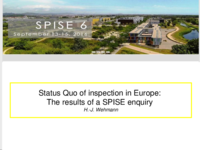
-
Technical requirements for inspections of PAEs in use
IP-GE
( pdf )

-
Yearly performed inspections and found out defects
IP-GE
( pdf )
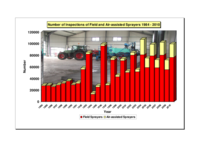
-
Relations between EU/CEN, federal and states regulations on the official inspection of PAEs
IP-GE
( pdf )
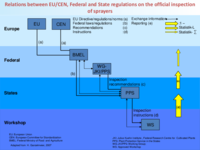
-
Plant Protection Act
IP-GE
( pdf )
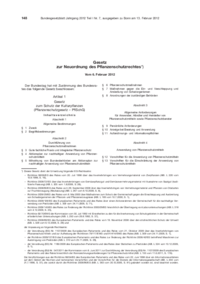
-
Plant Protection Equipment Ordinance
IP-GE
( pdf )
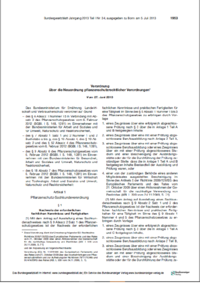
-
Examination and calibration of the test facilities
IP-GE
( pdf )
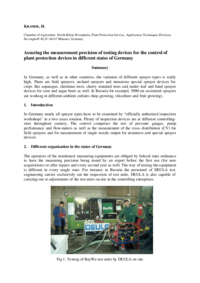
-
Syllabus for training courses for teaching inspection personnel
IP-GE
( pdf )

-
Checklist for the farmer – how to make preparations
IP-GE
( pdf )

-
Recommendations for handling contaminated water emanating from inspections
IP-GE
( pdf )

-
Examples for determining inspection fees
IP-GE
( pdf )
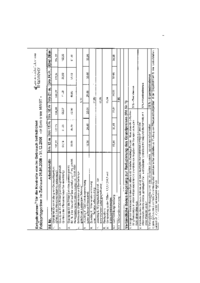
-
Plaque of approval
IP-GE
( pdf )
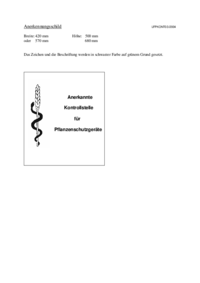
-
Inspection sticker
IP-GE
( pdf )
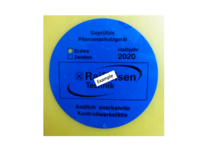
-
Inspection report form
IP-GE
( pdf )
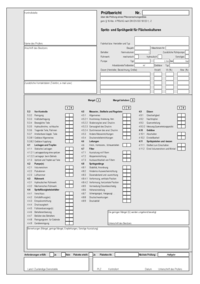
-
Application for recognition as an inspection workshop for PAEs
IP-GE
( pdf )
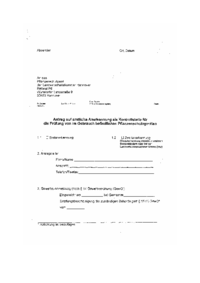
-
Application form for taking part in training for inspection personnel
IP-GE
( pdf )
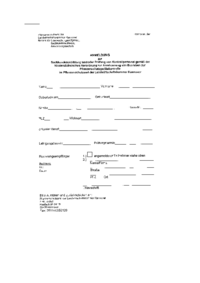
-
Certificate for having taken part in training / advanced training
IP-GE
( pdf )
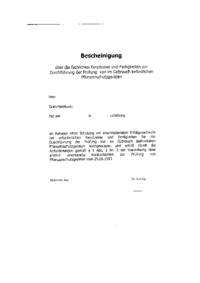
-
Forms for inspection workshops for reporting on inspections carried out and inspection stickers awarded, to be sent to the responsible plant protection authority
IP-GE
( pdf )

-
Form for ordering and returning inspection stickers
IP-GE
( pdf )
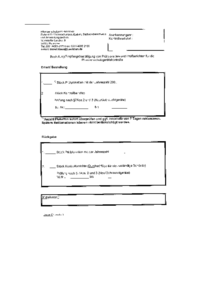
-
Form for confirming the date stated by the farmer for inspection
IP-GE
( pdf )

-
Form for calibrating inspection facilities
IP-GE
( pdf )
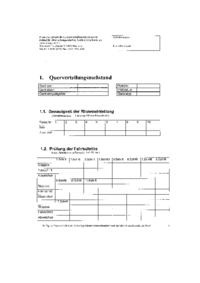
-
Form for monitoring PAEs regarding a valid inspection sticker
IP-GE
( pdf )

